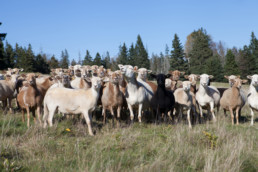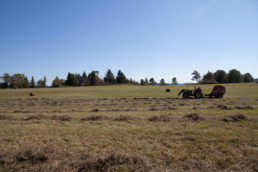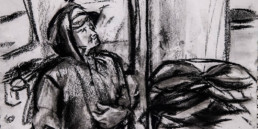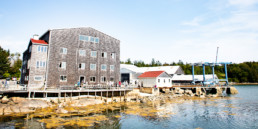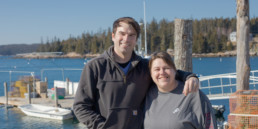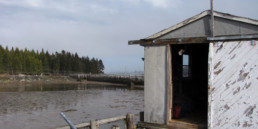Making Salt Hay While the Sun Shines
North Haven lamb, once prized on the Boston market, could be again.
Story and photos by Scott Sell
After nearly a year, Maya, Issie, and Velma still refuse to be sheep. They have acted like goats since their first days on the farm, and most days you can find the three of them with the goat herd, walking through the woods and taking naps in the cemetery. The couple of times Doreen has tried to put them in with the other lambs and ewes for a sleepover—to get them adjusted to being together—they cry their hearts out to go back to their adopted goat family or to be taken inside to watch TV on the sofa.
Life with farm animals is nothing if not chaotic. There is never a dull moment. And like most farmers, Sam and Doreen Cabot’s work days on North Haven’s Foggy Meadows Farm begin and end in the dark, most of their time devoted to their Katahdin sheep and Boer goats. Today, they have almost 80, in various states of pregnancy, hoof injury, and sickness. Along with the reluctant sheep, a mink has just killed one of the ducks. A ewe has complicated mating season by snubbing her suitor. Neighbors have suddenly stopped in to buy jams and frozen meat from Doreen’s farm store. Island deer have been eating the garden’s tomatoes as midnight snacks. And one of the young goats has gotten his head stuck in the fencing again. Even daily chores—which have to be done more or less the same way—can be different, given the weather or animal temperament or ferry schedule.
One thing is a constant at Foggy Meadows Farm, though: the sheep and goats feed throughout the year solely on grass and hay from several island fields that Sam mows, “teds”—or spreads out for drying—and bales himself.
Driving over to the north shore to bale the last cut for the season in late September, Sam points out several fields he hays, many of them old family farms, which amount to about 90 acres scattered around the island.
“That’s what you call a ‘Tootsie Roll’,” Sam says, pointing out a long line of hay bales, bunched up end to end without the ubiquitous white shrink-wrap. “They sit out in the fields all winter and the inside stays nice and dry.”
Hay on North Haven is mostly wild orchard grass, with a fair amount of clover and purple vetch. Sam and Doreen like it because it’s a fine-grain hay, very soft for the animals, especially the lambs and kids. A majority of the hay that’s sold on the mainland has been seeded, and, according to Sam, if it hasn’t been harvested at exactly the right time, it ends up being too coarse to eat. “They won’t touch it when it’s like that,” Sam explains.
“They claim that if you take a bunch of hay and squeeze it in your hands and it pricks you, that’s the same feeling the animal would have in its mouth.”
Like most jobs on an island, haying is a time-sensitive process and occupies much of Sam’s time throughout the summer and fall. He starts cutting in June and tries to finish by the beginning of August, before the hay matures. This allows the protein content to stay intact. Early on, before up-to-the-minute weather forecasts on the TV and Internet, Sam lost whole fields at a time when passing rainstorms suddenly drenched his tedded piles. When that happens, the protein leeches out and it turns to straw.
Now, after waiting nearly a week to get a few sunny days in a row, the hay on the north shore has dried out, and Sam hitches a red Hesston 530 hay baler on the back of his John Deere. It’s a round baler, capable of almost vacuuming up the hay as Sam drives the tractor slowly in long lines. And then, at the push of a button, the baler bundles the hay with twine and spits out a perfect round bale. Last year, Sam made about 240 round bales, a record.
“That’s the side you want to be on, having too much versus too little,” Sam says. “It’s like firewood. You want extra; you don’t want to run out. Those animals stay hungry.”
Even when there’s plenty of new pasture grass to eat, the sheep and goats don’t bulk up on it because it’s mostly water and doesn’t fill up the “rumen” section of their stomach. It’s the hay they need to help their digestive process. They need that dry matter to stick to their bones.
The animals have preferences on their hay, too. They especially love the hay that comes from along the edge of the water, like down on Amesbury Point, south of the house. That’s where “salt hay” grows: grasses that have ocean air constantly blowing over them, leaving a continuous layer of salt. Sam says that it’ll take almost a year for the animals to go through a salt lick that’s kept in the barn: they’re getting all the minerals they need from the salt in the hay.
“The animals tell me that it’s good,” Sam says. “When they dive into it, you can tell.”
The high salinity and iodine content of the grasses on the shore give prepared lamb a unique flavor and is considered to be a delicacy. It’s what French chefs call agneau de prê-salé, or “salt meadow lamb,” particularly those raised on marsh meadows on the northern coast of France. On North Haven in the mid-19th century, it was no different.
North Haven was just stone walls and wide-open pasture then, perfect for raising sheep for both wool and meat, which quickly became mainstays of the island’s economy. Among the 71 island farms of the time, all but one kept sheep. And at one point, sheep were the majority: the 1850 Agricultural Census reported 2,156 sheep on North Haven, approximately double the human population on-island at the time.
And North Haven lamb was so highly sought after that it was a specialty in many high-end restaurants in Boston and New York. Large boats would come up the coast and, in addition to the plentiful island produce, they would load countless sheep to carry to Boston, where North Haven lamb was its own commodity on the Boston Market.
“We’re hoping to regain some of that specialty with our animals,” Doreen says. “It would be nice to have that kind of niche, to have people excited about island lamb again.”
In the fall, the Cabots sold all of their ram lambs and some of their ewe lambs to be slaughtered for customers, mostly their island neighbors, who either bought whole animals or sides. Nebo Lodge, an inn and restaurant on the island, ordered 10 whole lambs that will be served as chops for dinner and sausage for breakfast during the upcoming season. And there’s a possibility that they’ll start selling their goat meat—often called chevon—to grocery stores in Portland, if there’s a market for it.
But they are reluctant to expand too much. For now, they’re trying to keep it simple.
“We’re not a very big farm and it’s only the two of us,” Sam says. “If it ever got really popular, we’d have to start expanding to more pasture, more fencing, more, more, more. How the hell would we keep up with it?”
On a warm fall morning, Sam is busy putting eastern- facing doors back on the barn and reinforcing the small animal shelters and hay houses, buttoning everything up for the oncoming cold and snow. The sheep watch with great interest as he measures and hammers and drills.
“When there’s no pasture to feed on in the winter, these critters go through a round bale in three days,” Sam says, laughing at them. “They’ll eat from morning until night and get as round as butterballs.”
Doreen comes down the hill to feed the goats, with Flossie the corgi and Maya the black sheep trailing close behind. Maya sidles up against Doreen’s thigh and gets a head scratch before Doreen runs her hand along the sheep’s spine.
“It’s not rocket science,” she says. “We usually go by body tone. If they’re energetic and their ears are up and they’re bright-eyed, then you’re doing it right. You just have to hang out with them so they can tell you.”
Although the winter allows Sam a break from haying and gives Doreen a chance to catch up on canning and crafts projects, they’re looking forward to warmer weather: after breeding ended in November, they’re expecting to welcome over 60 lambs and kids by the end of the spring.
And the big news on the farm is that the Cabots have new cattle, two Hereford steer, after finding an ad in Uncle Henry’s classifieds. It’s going to be a lot of work. A lot of new fencing will have to be put up and a new shelter will have to be built. But they’re excited. Their family farm started when they got their first Hereford calf, Uh-Oh, in 1979, and they haven’t had cattle since 1997. The couple’s five-year-old granddaughter Emma thinks the new steer should be called Dumb and Dumber. They, too, will feed on island hay.
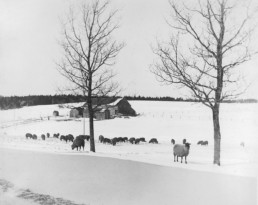
Scott Sell is a media specialist at the Island Institute.

